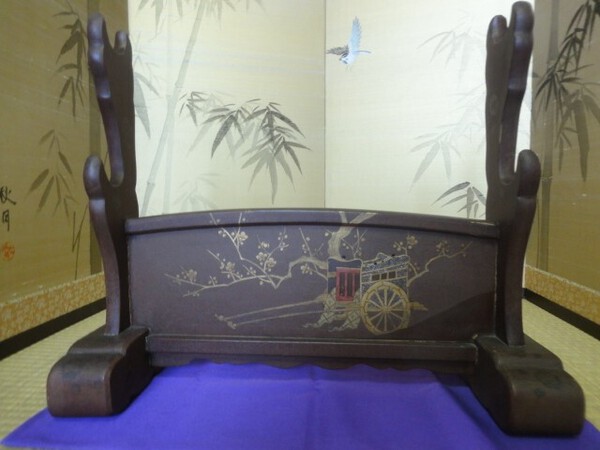
Yves
Members-
Posts
169 -
Joined
-
Last visited
Everything posted by Yves
-
Yes it is. Everything in water buffel horn.
-
Hi, Thanks for the replies. Ok that explains it a bit better. So that would mean that when worn the kozuka would be on the inside of the swords/saya if it is opposed to the kurigata. I was a bot worried that I still needed to find another set of those, but apparently the edge of the pocket can be of horn as well. I ordered my kurigata and koiguchi in horn so suppose they will line the pocket with horn as well.
-
The question is about the combination of a kogatana with kozuka into the pocket of the saya of a wackizashi. I sometimes see that the edge of the pocket where the kogatana slides into (the saya) is lined with a metal fitting. Is this the norm or is the kogatana slid into the pocket right under the kurigata? Thanks.
-
I've already tried to contact them via email, but they never responded.
-
Does anyone know of a traditional Japanese kamon designer? Preferably someone who could also convert it into a digital format so it can be embroided on clothes etc. Thanks.
-
A question: I was always of the opinion that the tabs holding the sword on a katanakake should be at the same level. Just came across one where this wasn't the case on the lower 2. One side is lower as if the sides were somehow inverted (impossible as the middle section is connected into the wood). Any ideas?
-
Edo period length and ownership restrictions
Yves replied to Mikaveli's topic in General Nihonto Related Discussion
Yes, reread. I corrected it. And I think you're wrong on the subject of sword length, but I wish you the best. -
Edo period length and ownership restrictions
Yves replied to Mikaveli's topic in General Nihonto Related Discussion
BTW: you should know that in iai the objective is not to fight longer than necessary and preferably kill after one single cut. If you don't hit a vital organ of your target, your opponent might still live and pose a threat. Kenjutsu is all good and fine for looks, but in reality a sword fight would be over in seconds. Usually the shortest sword movements would kill the fastest (like a stab when an oponent lifts his sword to cut and for that you need enough length. -
Edo period length and ownership restrictions
Yves replied to Mikaveli's topic in General Nihonto Related Discussion
See the above. There was a move going on after the sengoku away from close combat weapons to guns anyway. Naginata ended before that because of the extremely long yari used by foot solders.The Tokugawa ended that progression and halted it entirely. However, length is part of the equasion for the reasons I already gave. -
Edo period length and ownership restrictions
Yves replied to Mikaveli's topic in General Nihonto Related Discussion
As if they didn't train for real combat...why else would so many examples of Yoroi from the Edo era exist do you think. A bit shortsighted imo. Also consider the fact that if you would perform for example a kesa geri, you need to cut through the shoulder bone and chest bones to reach the heart. And occassionally we do train kenjutsu... it's primarily used to pefect timing. -
Edo period length and ownership restrictions
Yves replied to Mikaveli's topic in General Nihonto Related Discussion
I train Muso Shinden Ryu and both seitei and koryu styles. Jodo is extra curriculum. I have reached 3rd dan and I now have permission to use a real blade (which is ordered btw). Training with a real sword as far as I understood from those in our dojo that do train with one is that there is less room for error especially in drawing and noto. We normally never train with wakizashi, but in principle the older styles (omori, hazagawa, ukuden) are basically derived from fighting with the presence of a wakizashi (fuchi kashira in the middle of the body whereas in seitei the tsuba/sword cross is in the middle of the body). BTW: a sword is also used both sides where for example someone is hit with the tsuka in the chest, face or on the hand (i.e. tsukate, ganmenate, shi-ho geri) but you'll have to be extremely close to do that. Another aspect to consider as far as longer vs shorter swords is the extra momentum you have when you swing a longer (and usually heavier) sword is that it will help you cut through an opponent more easily. -
Edo period length and ownership restrictions
Yves replied to Mikaveli's topic in General Nihonto Related Discussion
Then you should know this. And as a said above, length of a sword is a trade of with other aspects. If length didn't matter, all the samurai would be wearing would be wakizashi or tanto. -
Edo period length and ownership restrictions
Yves replied to Mikaveli's topic in General Nihonto Related Discussion
Do you practice iai and jodo? I do, 17 years btw. And yes length does matter, not solely for practice reasons. Wonder how you will fare if I stick a jo up your nose. With 120 cm, you'll have a hell of time preventing that. -
Edo period length and ownership restrictions
Yves replied to Mikaveli's topic in General Nihonto Related Discussion
Playing stupid? What was not clear about what a wrote?? -
Edo period length and ownership restrictions
Yves replied to Mikaveli's topic in General Nihonto Related Discussion
We were talking about the length of the sword and the effectiveness of reach in the reason why a samurai might want to use a longer vs a shorter sword. The jo discussion was to make a point about the extreme length if you hadn't noticed. And indeed it was not about your penis length. -
Edo period length and ownership restrictions
Yves replied to Mikaveli's topic in General Nihonto Related Discussion
You do know that ordinary people trained in jodo to protect themselves against sword 'masters', do you? It is a known fact that it is very difficult for a swords man to win from a jodoka wielding a jo. The primary reason for this is length. And before we go into a discussion, yes, you can kill someone with a jo. -
Edo period length and ownership restrictions
Yves replied to Mikaveli's topic in General Nihonto Related Discussion
My .02$ All rules that I saw where practical of nature and were based on tried and true testing. For katana there is a way to determine the blade and tsuka length. This is basically the perfect balance between reach of the sword, being able to comfortably draw it and in the end it not being too heavy (too long and it would be become too heavy). The tsuka must be such that hte bottom bone of the left hand still touches the tsuka in order to stop it on a dawnward swing. That said, I could nowhere find any rule regarding the blade nor the tsuka length on a wakizashi. Practically you would need to be able to draw the sword with one hand without using sayabiki (swinging the saya backwards to facilitate the sword leaving the sheath). As such the length of a wakizashi, being a primarily one handed sword, would be limited on the basis of your arm length. I found out that in my case a wakizashi of 50cm would be the perfect length. Note that my katana perfect size is 75cm nagasa. The handle of the tsuka is another story. Most will say around 6 sun. Some say you need to be able to fit one and a half hand. In practice when wearing both the katana and the wakizashi, the handle cannot be too long as it would hinder drawing the katana. In my case this is 18 cm or roughly 6 sun. For example the perfect length tsuka on my katana (distance between my wrist and bottom of my elbow) is 9.5 sun. If a Japanese samurai would be using a katana of ca. 67 cm his wakizashi would probably be around 45 cm. Another thing to consider is that when sitting with both swords in the belt, the wakizashi is angled more downward. This means that the longer the blade is the more chance you have it will touch the floor which is to be avoided as it will make you sit uncomfortably and make noise + potentially damage the saya. I did testing with my regular iaito (2-4-5) and my boken (also 2-4-5) and practice was cumbersome with that length. The boken used as wakizashi would be pushed upward when sitting causing interference when drawing the katana as you need to put it horizontally to draw from a sitting position (mostly) So I think that a 59 cm wakizashi would be too much unless it would be a tall guy with very long arms. I mean someone like over 185 cm long. That would be very long for the middle-ages. Certainly in Japan. -
Thanks. For some reason, I cannot open the link.
-
Thanks. Anyway, although I like the piece, it's too expensive for my taste.
-
I do find taka-maki-e made by a certain Kajikawa (if the description is correct) associated with Late 18 - early 19th century https://www.metmuseu...lection/search/45440
-
Thanks Alex. I'm afraid I don't have the time to really study this in depth (plus I don't read Japanese), although I can see why this would be of interest. I have ordered myself a new set of swords from a Japanese smith (daisho) and they come with their respective shirasayas. I want to be able to display them and thus I would need something with a minimum of 4 tiers. As the swords are not cheap I want to have something that is fitting for them. Preferably not bulky but very fine in finishing and detail. Obviously I would immediately end up with something pre-Meiji. The following is also a very fine example, but way to expensive for my taste (costs as much as one of my swords actually) https://www.nipponto...swords6/ET560210.htm
-
Looks to me it is nearly impossible to date any of these within a reasonable amount of accuracy. (not this one, but in general)
-
The seller also seems to think it is Showa era. Makes me think there are not a lot of pre-Meiji era katanakake's for sale.
-







